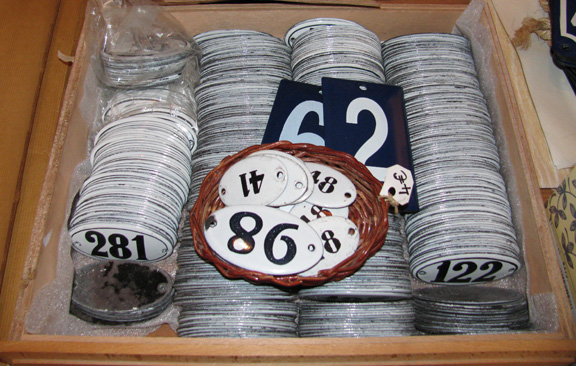
July 2009 – My favorite little shop in Paris, Plaques & Pots, one of the last living vestiges of the historical belly of Paris that was the Les Halles Quarter recently closed.
It had been a long time coming–rather, going. Selling enamel plaques, enamel street numbers, butcher’s paper and pottery handmade upstairs had some time been an anomaly in an quarter otherwise devoted to cafés, clubs, restaurants, and mass fashion. I stopped by to see owner and friend Josette Samuel, below, as she got ready to move on.
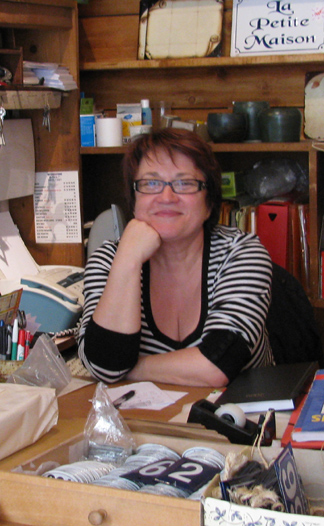
Her shop was one of the last authentic remnants of Les Halles, even if for some time already it had been a vision of the passing of time in the quarter as it pursued its drive to urban uniformity.
The wholesale and retail food industry left this area for modern installations in Rungis, south of Paris, in 1969, so the goods sold here long ago lost their place at Les Halles. Still, I’ve to got applaud her stubborn gumption in taking over in 2004 the shop at 12 rue de la Ferronerie formerly called Papeterie Moderne and trying to make a go of selling old-fashion practical-cum-decorative products in a space that’s probably smaller than your kitchen.
At Plaques & Pots Josette sold antique street numbers…
old street signs (left) and even old butcher’s paper (right) that she inherited from the previous owners.
Josette added her own clay pottery to the mix.  Knowing that I’ve always been a fan of this shop, both in her hands and in those of the prior owners (whom I first interviewed in 1991), Josette gave me this green pot as a farewell-to-the-boutique gift. Handmade in the Les Halles Quarter.
Knowing that I’ve always been a fan of this shop, both in her hands and in those of the prior owners (whom I first interviewed in 1991), Josette gave me this green pot as a farewell-to-the-boutique gift. Handmade in the Les Halles Quarter.
Several other vestiges of Les Halles from its by-gone centuries as the center of the food trade in Paris continue to hold their own. Among them:
– E. Dehillerin, a family-operated store for kitchen and pastry utensils and cookware, 18-20 rue Coquillière.
– La Poule au Pot, a bistro with a décor dated 1935, serving traditional rustic fare including one of the best onion soup’s in Paris, 9 rue Vauvilliers.
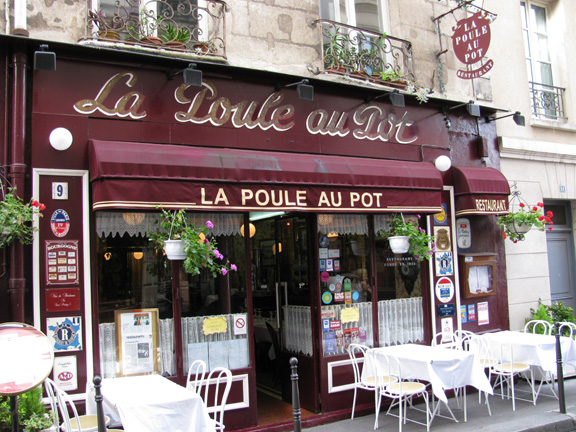
– Julien Aurouze, a family-run pest exterminator that was trapping rats around Les Halles as early as 1872, 8 rue des Halles. Those are sewer rats caught in the quarter in 1925 hanging in the window on the right below.
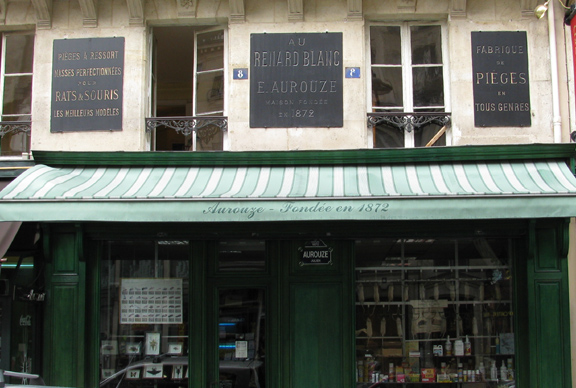
The oldest and most lasting of the remnant of historical Les Halles is the Church of Saint Eustache, 1532-1640, which may well be the most under-visited, touristically speaking, of the major churches of Paris. It’s a Renaissance church within a Gothic body with great accoustics for its famous organ.

The enormous proportions of its interior are worth a look, but I’ve come here today to photograph one of the most endearing church sculptures in Paris, “Departure of the Fruits and Vegetables from the Heart of Paris 28 February 1969” by Raymond Mason.
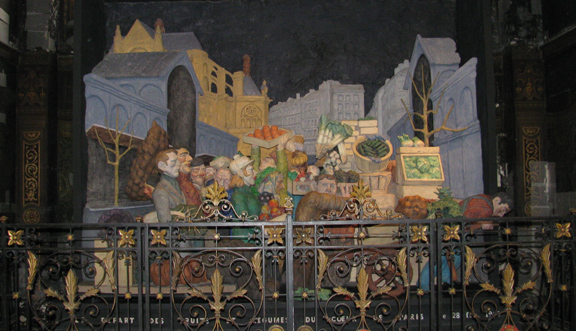
“Departure” (completed in 1971) is so fitting at Saint-Eustache not only because the central food market that had existed since the Middle Ages was the raison d’être for the church but because this is a wonderful sculptural retelling of Paradise Lost, the departure from the Garden of Eden. (Also reminiscent of the departure from Anatevka at the end of Fiddler on the Roof.) Or, as the sculptor has written of that departure 40 years ago, “It’s the man of the Middle Ages that’s leaving.”
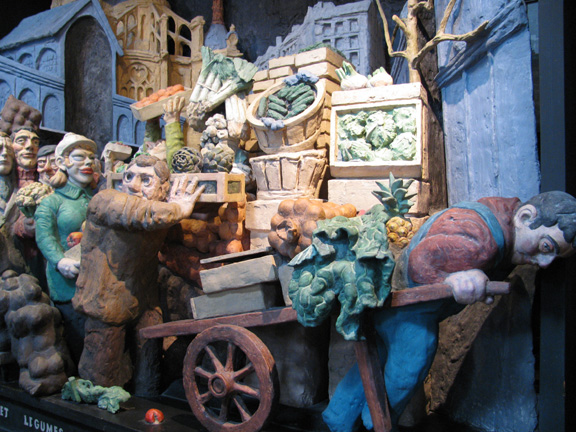
Plaques & Pots, formerly Papeterie Moderne, now joins the procession in the departure of signs and numbers from the heart of Paris July 2009.
Wishing Josette all the best in her future endeavors.



Because of this post, I visited Josette today and found a nice little sign to take back to Seattle with me. I had to refrain from buying more because my suitcases are all close or over the 50 pound limit (yikes!). It is indeed a very cute shop and I felt sad that it was closing. Josette is charming and so sweet. She gave me as a gift a “vrai souvenir of Paris” – a butter slicer. Thanks for the post!!!!
Kathie,
I’m so glad you were able to get to know that precious little piece of old Paris before it disappears. Send me a picture of your sign in whatever special place you find for it back home. And enjoy the butter slicer.
Gary
In 1971 as an American student hitching my way through Europe I had Les Halles at the top of my Paris agenda. I took many pictures of the disappearing cast iron architecture that was Les Halle. I still have memories and photos that remind me why places like Les Halle are so important for a vibrant and exciting city. I would love to know what happened to the cast iron columns.
David,
Here’s a link to a French news film from 1971 showing Les Halles at the time that you would have been here:
http://www.ina.fr/video/CAF97511634
Of the 12 iron and glass pavilions designed by the architect Victor Baltard and built starting in the 1850s only one was fully dismantled and rebuilt elsewhere (Nogent-sur-Marne, a suburb of Paris). Other than a few pieces found elsewhere, Baltard’s pavilions were destroyed, to the regret of many.
Hi, wonderful article! I notice that in the 2012 Google street view Josette’s shop is still there (rat-catcher sadly gone, though). Is it possible that someone else took over the shop? I’m about to send someone who is visiting Paris to Josette’s shop if it’s still there.
thanks!! (and where did all the stuffed rats end up?)
Linda: Josette’s shop is now long gone but the rat-catcher/pest control shop Aurouze is still nearby at 8 rue des Halles. See http://www.aurouze.fr/